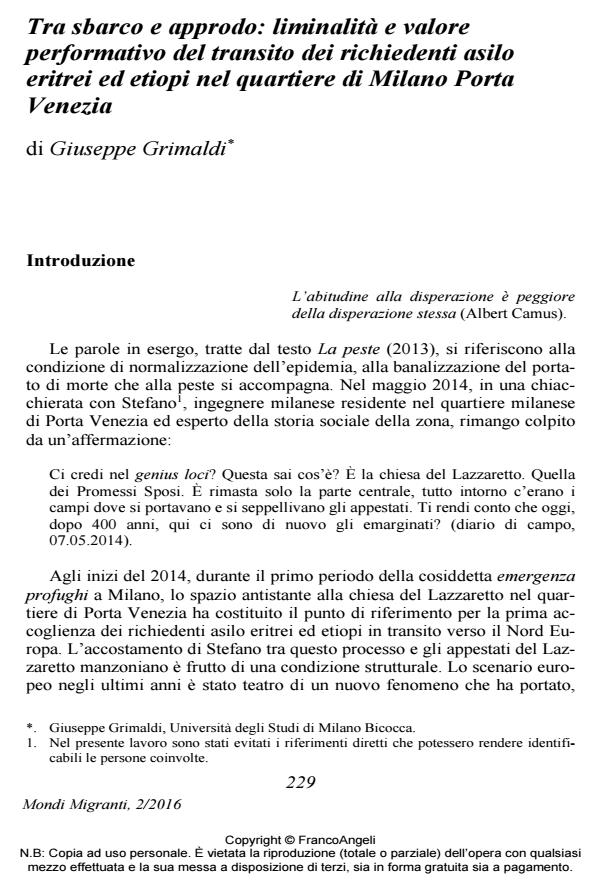Between disembarkation and haven. Liminality and the performative value of the transit of Eritrean and Ethiopian asylum seekers in the neighborhood of Milano Porta Venezia
Journal title MONDI MIGRANTI
Author/s Giuseppe Grimaldi
Publishing Year 2016 Issue 2016/2
Language Italian Pages 19 P. 229-247 File size 189 KB
DOI 10.3280/MM2016-002012
DOI is like a bar code for intellectual property: to have more infomation
click here
Below, you can see the article first page
If you want to buy this article in PDF format, you can do it, following the instructions to buy download credits

FrancoAngeli is member of Publishers International Linking Association, Inc (PILA), a not-for-profit association which run the CrossRef service enabling links to and from online scholarly content.
Placing the ethnographic research in the neighborhood of Milano Porta Venezia, the reference space of Eritrean and Ethiopian diaspora in Milan, the essay sheds light on the productive character of the transit of Eritrean and Ethiopian asylum seekers directed to the North of Europe. By analyzing the structural conditions of the transit and putting it in an institutional frame marked by invisibility, the author considers the current phenomenon as a liminal phase in the transnational government system of forced migrations. A liminal phase which inaugurates a new dense space situated between the terms disembarkation and haven, that involves new social actors and opens new imageries in the construction of the migratory project. In this way, the neighborhood of Porta Venezia represents a space dense of social meanings where it is possible to investigate the social processes nourishing this phenomenon and its performative value in relation to the local models and the social belonging in diaspora.
Keywords: Liminality, Eritrea, Asylum seekers, Locality, Dublin System, Invisibility.
- Survivors-at-home and the right to know: solidarities in Eritrea in the aftermath of the Lampedusa tragedy Valentina Fusari, in Journal of Eastern African Studies /2024 pp.135
DOI: 10.1080/17531055.2024.2333652 - Asilo e crisi urbane: dinamiche di narrative-making tra media e policy network locali Andrea Pogliano, Irene Ponzo, in MONDI MIGRANTI 1/2019 pp.119
DOI: 10.3280/MM2019-001008 - Languages of Discrimination and Racism in Twentieth-Century Italy Marcella Simoni, Davide Lombardo, pp.1 (ISBN:978-3-030-98656-8)
- Who Feels Safe? Uncertain Futures and Enduring Aspirations in Italy Daniela Giudici, in Geopolitics /2024 pp.1
DOI: 10.1080/14650045.2024.2349633 - Migrants and Refugees: Bottom-Up and DIY Spaces in Italy Marco Cremaschi, Flavia Albanese, Maurizio Artero, in Urban Planning /2020 pp.189
DOI: 10.17645/up.v5i3.2921 - Obstructing lives: local borders and their structural violence in the asylum field of post-2015 Europe Maurizio Artero, Elena Fontanari, in Journal of Ethnic and Migration Studies /2021 pp.631
DOI: 10.1080/1369183X.2019.1608168 - Il diritto di restare: il Regolamento Dublino, i volti, le storie e le possibili buone pratiche Ilaria Sommaruga, Annapaola Ammirati, in MONDI MIGRANTI 1/2018 pp.107
DOI: 10.3280/MM2018-001006 - Introduction. Civil society on the edge: actions in support and against refugees in Italy and Germany Elena Fontanari, Giulia Borri, in MONDI MIGRANTI 3/2018 pp.23
DOI: 10.3280/MM2017-003002 - Germany, year 2020. The tension between asylum right, border control, and economy, through the imperative of deservingness Elena Fontanari, in Migration Studies /2022 pp.766
DOI: 10.1093/migration/mnac019
Giuseppe Grimaldi, Tra sbarco e approdo: liminalità e valore performativo del transito dei richiedenti asilo eritrei ed etiopi nel quartiere di Milano Porta Venezia in "MONDI MIGRANTI" 2/2016, pp 229-247, DOI: 10.3280/MM2016-002012